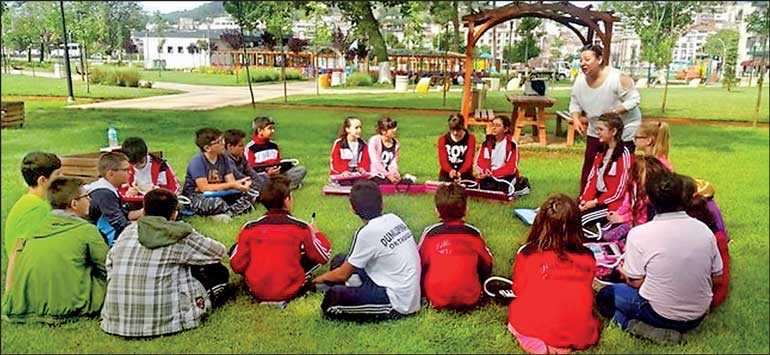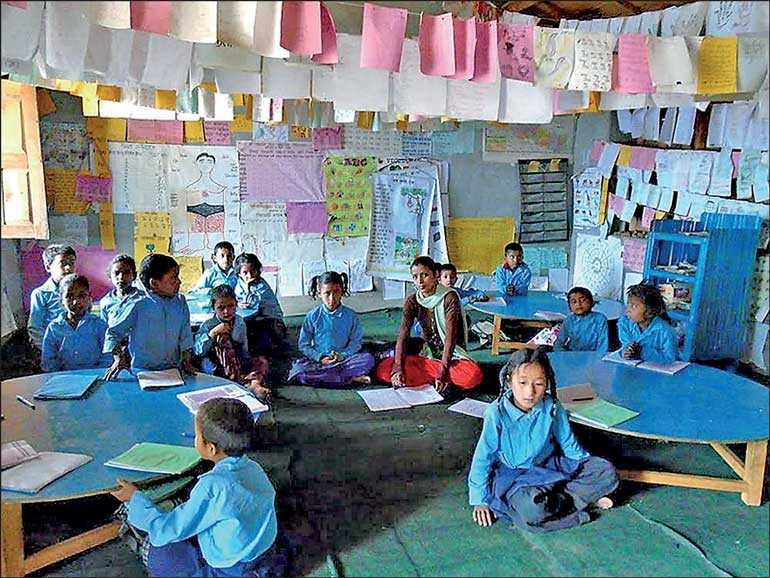Saturday Apr 05, 2025
Saturday Apr 05, 2025
Tuesday, 17 December 2019 00:00 - - {{hitsCtrl.values.hits}}


“OK, children now it’s time to copy down what’s on the board…!”
Most of you might have been the victims of these clichés for years in a stagnant classroom with too much speaking done by the teacher. 
Creating a student-friendly classroom to teach English in Sri Lanka, has been a dream for decades. Although the term is very well familiarised by most of the English teachers in Sri Lanka, the implementation of a student friendly classroom has encountered practical problems, which were not sufficiently addressed by the teachers as well as the responsible authorities.
Before scrutinising the due reasons for the inability to implement a student-friendly classroom, let’s redefine the terms!
A student-friendly classroom is a place where the teacher acts as a facilitator or a guide. The teacher is well tolerant of students’ ideas. There is enough room to practice student’s brainstorming sessions. In other words, the teacher does not intervene with the student’s tasks unless she/he is asked for help.
Thus the teacher’s contribution for the lesson is ideally 40%, and the student’s contribution is 60% when learning a language like English. It’s really important that the students are given enough time and space to practice the language components, as well as to overcome their language anxieties.
Now the problem is, “Do the teachers have enough capabilities to create a student-friendly classroom? The answer is “Yes”.
As said by Miagi in ‘Karate Kid,’ “There are no bad students, but only bad teachers.” A teacher can become a facilitator in a student friendly classroom, without a single resource. Taking one such instance, the teacher can go out of the classroom, sit under a tree with students. Then she/he could start a conversation with the students on nature. The students can gradually contribute. The teacher does not try to intervene with them when they start expressing their ideas. However when they finish the task, the teacher could correct some pronunciation mistakes or any other noticeable areas, without overdoing it. Thus it allows creating a student friendly classroom, although there is no such physical setting. It is therefore clear that the teachers are not obligated to have extraordinary talents to create a student friendly classroom.
Are they reluctant to detach themselves from the traditional teacher dominant methods in teaching English? The answer is “No”.
In this concept, the teachers have to be avid readers of latest developments of English language teaching. The teachers should also at the same time be passionate and creative in their approaches. Hence, it’s a matter of finding due time to read. Most of them can always use their smart phones to Google on the internet to look for knowledge whenever they are on a break. Or maybe they could arrange a day each week for formal discussions. They can discuss the latest developments on English language with other teachers.
“Should the authorities be blamed for not priority enough resources to create student-friendly English classroom? The answer is “No”.
The authorities are then not pressed to provide due resources, but they are now free to allocate due time for the timely discussions for teachers, which is in a way, less demand for them. Not only the teacher (teacher discussions), the students should also be given a day to discuss their problems with teachers. This is a more humanistic approach. When the students get the authority over the topics to be taught in the classroom. This approach rejects the overuse of text books in the classroom, which is again a passive approach for students.
Thus, it is evident that creating a student friendly environment is not difficult. It does not require many resources, it does not make unnecessary demands from the authorities. It is when the teachers start to enlighten themselves. It is when the teachers become passionate about what they do. It is when the students become less dependent on the teacher although they have less resources. After all, it is where the student dominates the classroom.
Thus, if the teachers adopts a student dominant classroom, it can be even extended to schools in rural areas to teach English for students. More than the children from town, those who are from rural areas can benefit from this approach, as they do not need all the facilities to learn in an interactive classroom.
(The writer is currently working as a senior lecturer in English language at Lanka TEFL Training Institute, Dehiwala and works as an English visiting lecturer at Kotelawala Defence University. She has an MA in Linguistics from University of Kelaniya. She is an author on the subject of ‘English’ and ‘English Literature’ targeting OL and AL students in Sri Lanka. She can be contacted via [email protected].)
Discover Kapruka, the leading online shopping platform in Sri Lanka, where you can conveniently send Gifts and Flowers to your loved ones for any event including Valentine ’s Day. Explore a wide range of popular Shopping Categories on Kapruka, including Toys, Groceries, Electronics, Birthday Cakes, Fruits, Chocolates, Flower Bouquets, Clothing, Watches, Lingerie, Gift Sets and Jewellery. Also if you’re interested in selling with Kapruka, Partner Central by Kapruka is the best solution to start with. Moreover, through Kapruka Global Shop, you can also enjoy the convenience of purchasing products from renowned platforms like Amazon and eBay and have them delivered to Sri Lanka.
Discover Kapruka, the leading online shopping platform in Sri Lanka, where you can conveniently send Gifts and Flowers to your loved ones for any event including Valentine ’s Day. Explore a wide range of popular Shopping Categories on Kapruka, including Toys, Groceries, Electronics, Birthday Cakes, Fruits, Chocolates, Flower Bouquets, Clothing, Watches, Lingerie, Gift Sets and Jewellery. Also if you’re interested in selling with Kapruka, Partner Central by Kapruka is the best solution to start with. Moreover, through Kapruka Global Shop, you can also enjoy the convenience of purchasing products from renowned platforms like Amazon and eBay and have them delivered to Sri Lanka.